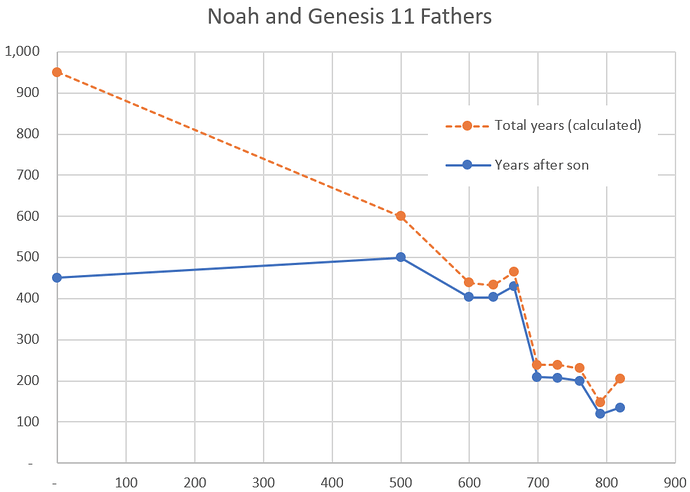If Genesis described God killing Enoch and Elijah earlier, I’d agree. That would seem to show belief in a positive afterlife. Since the text actually goes out of its way not to describe it as death, it isn’t such a compelling point for life after death.
There is no exponential decay in the numbers from Noah to Abraham. The decay curve only arises when one adds cherry-picked numbers after Abraham (as I discussed last post).
But I am with you in thinking the period from Noah to Abraham is worth a closer look. Constraining ourselves to that period avoids cherry-picking: with the exception of Noah, those ages all come out of Genesis 11, and they are all the ages given there.
Here are two charts with that data. I didn’t superimpose a curve since I don’t want to bias us towards finding an overall trend and instead want the data to speak for itself. In the first chart, the x axis shows the number of years since Noah. In the second, it shows the generation from Noah.
The most striking thing in the chart, to me, is the stairstep in the middle. The first five numbers fit one curve, and the second set of five numbers fit a lower curve. The text also draws attention to that point, since Peleg not only divides the genealogy in half, but Genesis 10:25 states that in his day the earth was divided. It seems that the numbers, the structure of the genealogy and the terse biographical details all highlight Peleg as the most significant individual between the endpoints.
Beyond that, another interesting feature can be seen with the blue lines. Almost all of the ages given for how long someone lived after their son’s birth are close to a multiple of 100. Noah and Terah aren’t exceptions, since their years-after-birth figures are calculated rather than stated. So when you look at the numbers given, rather than the numbers we can calculate, they stairstep from 500 to (403, 403, 430) to (209, 207, 200) to 119. The final number, 119, is very close to 120, which God said would be the days of humanity (Genesis 6:3).
So Genesis 11 seems to link the long lifespans of Genesis 5 (ending with Lamech who lives 595 – roughly 600 – after his son’s birth) to the new lifespan of 120 through using a stairstep progression that goes down by hundreds. This pattern is clearest in the ages given, not the total ages that can be calculated. The biggest descent – roughly 200 years in one generation – happens with Peleg, since the text highlights his day as bringing division.
In all, the numbers seem very intentional, and they underscore the same message told by the text. But they don’t speak of exponential decay or, in my mind, of brute historical facts.

